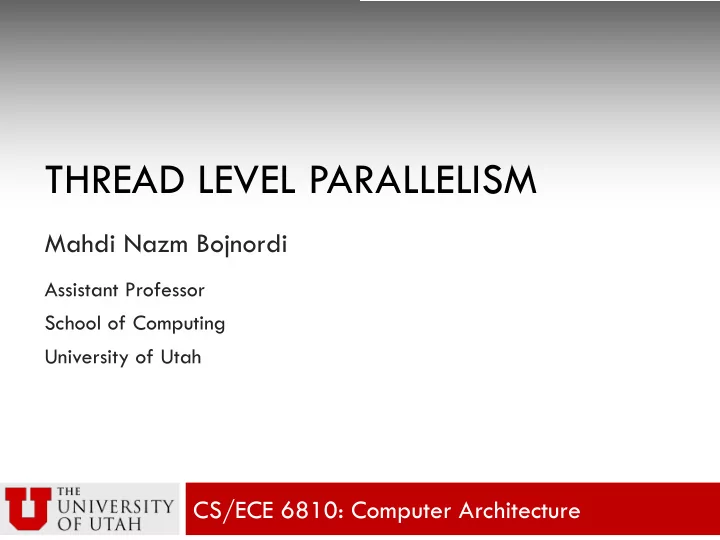

THREAD LEVEL PARALLELISM Mahdi Nazm Bojnordi Assistant Professor School of Computing University of Utah CS/ECE 6810: Computer Architecture
Overview ¨ Announcement ¤ Homework 4 is due on Dec. 11 th ¨ This lecture ¤ Thread level parallelism (TLP) ¤ Parallel architectures for exploiting TLP n Hardware multithreading n Symmetric multiprocessors n Chip multiprocessing
Flynn’s Taxonomy ¨ Forms of computer architectures Instruction Stream Single Multiple Single-Instruction, Multiple-Instruction, Single Single Data (SISD) Single Data (MISD) Data Stream uniprocessors systolic arrays Multiple-Instruction, Single-Instruction, Multiple Data Multiple Multiple Data (SIMD) (MIMD) vector processors multiprocessors
Flynn’s Taxonomy ¨ Forms of computer architectures Instruction Stream Single Multiple Single-Instruction, Multiple-Instruction, Single Single Data (SISD) Single Data (MISD) Data Stream uniprocessors systolic arrays Multiple-Instruction, Single-Instruction, Multiple Data Multiple Multiple Data (SIMD) (MIMD) vector processors multiprocessors
Basics of Threads ¨ Thread is a single sequential flow of control within a program including instructions and state ¤ Register state is called thread context ¨ A program may be single- or multi-threaded ¤ Single-threaded program can handle one task at any time ¨ Multitasking is performed by modern operating systems to load the context of a new thread while the old thread’s context is written back to memory
Thread Level Parallelism (TLP) ¨ Users prefer to execute multiple applications ¤ Piping applications in Linux n gunzip -c foo.gz | grep bar | perl some-script.pl ¤ Your favorite applications while working in office n Music player, web browser, terminal, etc. ¨ Many applications are amenable to parallelism ¤ Explicitly multi-threaded programs n Pthreaded applications ¤ Parallel languages and libraries n Java, C#, OpenMP
Thread Level Parallel Architectures ¨ Architectures for exploiting thread-level parallelism Hardware Multithreading Multiprocessing q Multiple threads run on the q Different threads run on same processor pipeline different processors q Multithreading levels q Two general types o Coarse grained o Symmetric multiprocessors multithreading (CGMT) (SMP) § o Fine grained multithreading Single CPU per chip (FGMT) o Chip Multiprocessors (CMP) § o Simultaneous multithreading Multiple CPUs per chip (SMT)
Hardware Multithreading
Hardware Multithreading ¨ Observation: CPU become idle due to latency of memory operations, dependent instructions, and branch resolution ¨ Key idea: utilize idle resources to improve performance ¤ Support multiple thread contexts in a single processor ¤ Exploit thread level parallelism ¨ Challenge: the energy and performance costs of context switching
Coarse Grained Multithreading ¨ Single thread runs until a costly stall—e.g. last level cache miss ¨ Another thread starts during stall for first ¤ Pipeline fill time requires several cycles! ¨ At any time, only one thread is in the pipeline ¨ Does not cover short stalls ¨ Needs hardware support ¤ PC and register file for each thread
Coarse Grained Multithreading ¨ Superscalar vs. CGMT FU1 FU2 FU3 FU4 FU1 FU2 FU3 FU4 Coarse Grained Multithreading Conventional Superscalar
Fine Grain Multithreading ¨ Two or more threads interleave instructions ¤ Round-robin fashion ¤ Skip stalled threads ¨ Needs hardware support ¤ Separate PC and register file for each thread ¤ Hardware to control alternating pattern ¨ Naturally hides delays ¤ Data hazards, Cache misses ¤ Pipeline runs with rare stalls ¨ Does not make full use of multi-issue architecture
Fine Grained Multithreading ¨ CGMT vs. FGMT FU1 FU2 FU3 FU4 FU1 FU2 FU3 FU4 Coarse Grained Multithreading Fine Grained Multithreading
Simultaneous Multithreading ¨ Instructions from multiple threads issued on same cycle ¤ Uses register renaming and dynamic scheduling facility of multi-issue architecture ¨ Needs more hardware support ¤ Register files, PC’s for each thread ¤ Temporary result registers before commit ¤ Support to sort out which threads get results from which instructions ¨ Maximizes utilization of execution units
Simultaneous Multithreading ¨ FGMT vs. SMT FU1 FU2 FU3 FU4 FU1 FU2 FU3 FU4 Simultaneous Multithreading Fine Grained Multithreading
Multiprocessing
Symmetric Multiprocessors ¨ Multiple CPU chips share the same CPU 0 CPU 1 memory CPU 2 CPU 3 ¨ From the OS’s point of view app ¤ All of the CPUs have equal compute app app capabilities OS ¤ The main memory is equally accessible by the CPU chips ¨ OS runs every thread on a CPU ¨ Every CPU has its own power distribution and cooling system AMD Opteron
Chip Multiprocessors ¨ Can be viewed as a simple SMP on single chip Core Core Core … 0 1 3 ¨ CPUs are now called cores ¤ One thread per core Shared cache ¨ Shared higher level caches ¤ Typically the last level ¤ Lower latency ¤ Improved bandwidth ¨ Not necessarily homogenous cores! Intel Nehalem (Core i7)
Why Chip Multiprocessing? ¨ CMP exploits parallelism at lower costs than SMP ¤ A single interface to the main memory ¤ Only one CPU socket is required on the motherboard ¨ CMP requires less off-chip communication ¤ Lower power and energy consumption ¤ Better performance due to improved AMAT ¨ CMP better employs the additional transistors that are made available based on the Moore’s law ¤ More cores rather than more complicated pipelines
Efficiency of Chip Multiprocessing ¨ Ideally, n cores provide n x performance ¨ Example: design an ideal dual-processor ¤ Goal: provide the same performance as uniprocessor Uniprocessor Dual-processor Frequency 1 ? Voltage 1 ? Execution Time 1 1 Dynamic Power 1 ? Dynamic Energy 1 ? Energy Efficiency 1 ?
Efficiency of Chip Multiprocessing ¨ Ideally, n cores provide n x performance ¨ Example: design an ideal dual-processor ¤ Goal: provide the same performance as uniprocessor f � V & P � V 3 à V dual = 0.5V uni à P dual = 2 × 0.125P uni Uniprocessor Dual-processor Frequency 1 0.5 Voltage 1 0.5 Execution Time 1 1 Dynamic Power 1 2x0.125 Dynamic Energy 1 2x0.125 Energy Efficiency 1 4
Recommend
More recommend